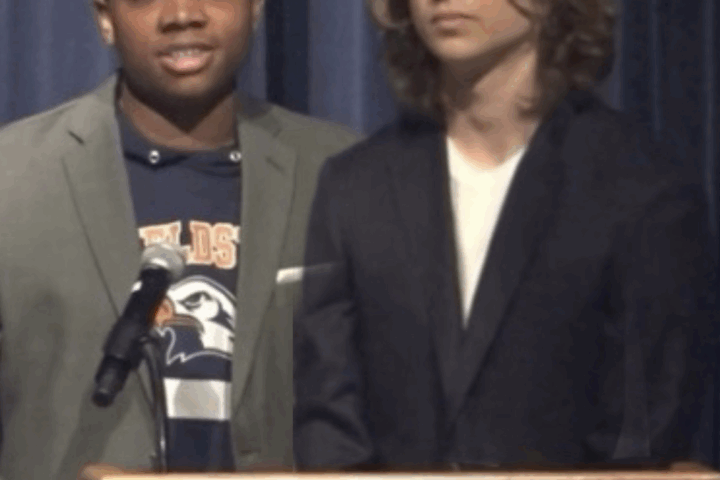More suited for a biomedical supplements company or Sunset Home for the Elderly and Infirm than the Ethical Culture Fieldston School, our school’s new logo is more than just a visual disgrace — its development runs contrary to our shared values and collective history. There was no indication of a problem with the traditional logo, no advertisement of the presence of a committee to reconsider our school’s brand and no survey or proactive outreach to the community. The forced imposition of the logo was blunt, careless and condescending. It didn’t have to be this way.
The development of a new school logo (had it been determined to be necessary) should have been an opportunity for community building. It should have brought the school together around what is only now being sold to the community as a recentering on our traditional slogan, fiat lux (let there be light), from the time of our founder, Felix Adler. We will not argue that the tree symbol is as important to the school as Adler; however, the tree is arguably more present and relevant to Fieldston community today than is the social reformer, rabbi and educational leader.
Visually, more so than the “tree,” this logo is elementary. The logo is corporate, perhaps an even more significant insult from within the Fieldston community. The logo is said to be based on Fieldston’s official seal, an open book with a sun above it. However, perhaps the reason the school moved away from the seal in the 20th century and towards the tree symbol may be its similarity to the seals of many higher educational institutions. The original seal is almost identical to those of Clark University and Bucknell University and similar to those of the University of Delaware, Middlebury College and Lehigh University. The sun, on the other hand, looks like an inverted PSEG logo, a Long Island and New Jersey utility company, and it appears similar to a monstrance, a Roman Catholic religious article. In addition, the notion that the tree has been our symbol for only two decades is demonstrably false. An early iteration of the tree logo was present in a 1911 issue of Inklings, and a modernist tree logo represented the school through the mid 1990s. While the tree was affectionately known as the “broccoli,” the new logo quickly gained a vulgar moniker that crudely refers to a human orifice. To put it simply and more politely, no one likes it. For fear of combining two controversies, the new logo appears to be the Fieldston Fence stretched around the circumference of a circle.
The process has been anything but transparent, fair or ethical. The absence of any discussion proves that the logo development was done secretly, as to hide the change and any discussion from the Fieldston community. At Fieldston, we have committees for committees. It took years to develop the Academic Integrity Board (AIB), a committee that ensures student commitment to honest work. At Fieldston, committees choose the summer reading book, plan Modified Awareness Days (MADs) and interview and recommend administrative leaders. Had the school developed the new logo in a process imbued with openness, student, faculty and alumni input would have been integral. This input was, in fact, integral for the selection of new chairs for the renovated Tate Library. For weeks, multiple chair, study carrel and table options were displayed in the Student Commons for community feedback. Our input mattered for these chairs, yet somehow not for the logo, which is the one image that represents our school. Instead, this purposeful subterfuge runs contrary to our values of integrity, inclusivity and dialogue.
This could have been done differently. In the absence of a timeline for this logo’s development, we suggest what could have been a different path. In the Fall of the 2017-2018 school year, the administration could have sent out an email to the community describing its desire to have a conversation about our school’s identity (or brand, image and marketing). Had we decided to refocus on the school’s official motto, fiat lux, we could have held a discussion regarding the ways in which we could reevaluate our mission, including reevaluating the logo. The school could have held a student design contest across divisions, with each division voting on its favorite. After, a final product could have been offered to the community as a whole and compared to the tree. A decision made in this manner would be one that reflects the desires of the school.
Instead, we are now left to pick up the pieces. A lot will change: the website will be updated with the new logo, every newly updated piece of signage will be replaced and all stationery, letterheads, materials and novelty PopSockets will be trashed. The rhetoric of a community-wide rededication to what are supposedly the original values of the school raises its own questions. If we needed to recommit ourselves to these values, where did we go wrong? Was it when the tree was selected as our logo? If not, isn’t a cosmetic change to our branding merely a Band-Aid on a systemic problem that plagues the school? If we truly want to recenter ourselves on the values evoked by “fiat lux,” we suggest actually investing in their application rather than forcefully compelling the adoption of disingenuous ones.





